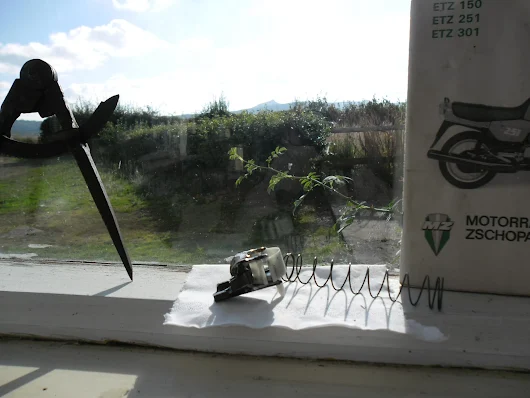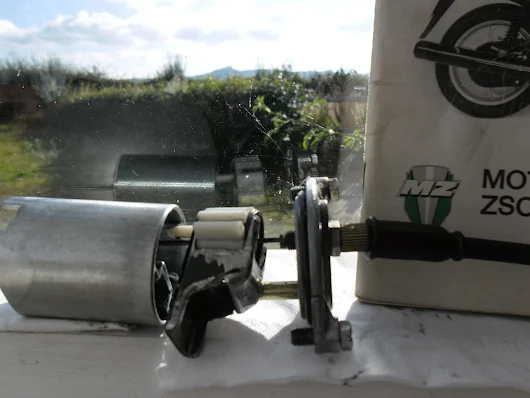MZ 32mm Teleskopgabel
mz301escocia
Wednesday, 20 February 2019
Monday, 11 February 2019
Tuesday, 25 April 2017
Going on holiday in Great Britain
 |
| In the beginning ... Day One, 0 miles |
 |
| The Twa Brigs or Third over Forth Day One, 140 miles |
 |
| Reading Day Two, 600 miles |
 |
| Day Five, 990 miles |
 |
| Day Five, 990 miles |
 |
| Day Seven, 1000 miles |
 |
| Day Seven, 1000 miles |
 |
| Day Seven, 1000 miles |
 |
| Day Eight, 1120 miles |
 |
| Day Eight, 1180 miles |
 |
| Day Eight, 1190 miles |
 |
| Day Eight, 1230 miles |
 |
| Day Eight, 1250 miles |
 |
| Day Eight, 1290 miles |
 |
| Day Nine, 1330 miles |
 |
| Day Nine, 1370 miles |
 |
| Day Ten, 1390 miles |
 |
| Day Ten, 1420 miles |
 |
| Weymouth Day Thirteen, 1610 miles |
 |
| The last Mod in Dorset Day Thirteen, 1620 miles |
 |
| Carter Bar on the A68 Day Fifteen, 2130 miles |
 |
| The Eildon Hills Day Fifteen, 2150 miles |
 |
| The Athens of the Central Belt Day Fifteen, 2200 miles |
 |
| The Davidson Legacy Cottage, Angus Day Fifteen, 2280 miles |
Tuesday, 4 November 2014
Walter Kaaden's disc valve racers and the Australian Engineer
Motorcycle Engineering
Phil
Irving
Each chapter of this book is based on an article written
for the English magazine Motor Cycling and originally published in the
1950s or early 1960s under the pen-name of Slide Rule. Phil Irving worked in England Australia
I have extracted the material on MZ two-stroke racing engines designed by Walter Kaaden. Taken from
the Clymer Publications/Speedsport edition; 5th reprint; 1973.
Fin
Effectiveness p.194
… Nevertheless, there is obviously good reason for
locating the exhaust at the front, or if this is not practicable, at the rear rather than at the sides, as is done indeed on the M.Z. two-stroke. Considerable lengths have been gone to in this engine to reduce the pick-up of heat in the exhaust-ports; although there are two cut in each cylinder, they merge quickly into a single outlet, the length from bore to flange-face being less than two inches (Fig. 10.19).
Central-drive
Twins p.203
Recently, it has become a trend in racing design to
construct tiny twins as two individual single-cylinder engines attached to a
central component containing the primary drive and (in four-strokes) the drive to the valve-gear. This is of particular advantage for cooling in such designs as the 250 c.c. M.Z., and is still useful in the case of a four-stroke, though to a lesser extent ...
Inlet
Port Control p.247
The valve itself is of sheet steel, 0.020" in. thick, and rotates in a space only 0.040 in. wide. It is not mounted firmly on the mainshaft, but is driven by splines so that it can centralize itself in the gap or move to one side or the other, so acting like a reed-valve during the closed periods. The periphery is cut away to open the port, which then has a
… Units have been made with just a pair of gears … if all
the ratios in the box are indirect-as in the M.Z., for instance- … the engine
rotates “forward”, so that a single pair of primary gears is suitable.
Basic
Unit Layouts p.315
… With a transverse four-cylinder engine, excessive width
would be created if the drive were taken off one end of the shaft. … On the
Rondine … taking the drive from the centre of the shaft …
GEARBOXES AND TRANSMISSION 319
There has been a tendency in recent years for English designers to adopt what might be termed "semi-unit" construction. In this system, a flat face is machined on the back of an otherwise conventional crankcase and bolted thereto is a gearbox which has a mating surface machined on its front face. The rear half of the chaincase may be cast integrally with the drive-side half of the crankcase, as in the B.S.A. twins,* or it may be a separate bolted-on component.
In this construction, there are no shear loads...
Although at first sight it does not appear to do so, the 125 c.c. M.Z. utilizes this built-up principle, but in conjunction with an all-indirect gearbox and cross-over drive, which results in a neater and stiffer unit than would be obtained with both drives on one side.
*Early model BSA A7/A10/Kawasaki Commander with bolt-up gearbox and primary chain tensioner.
٭ Kadenacy found, by ingenious experiments with a special engine, that if the exhaust ports were large and opened with sufficient rapidity the imprisoned gas would rush out at such high velocity that it continued rushing out until the port was closed again, by which time the pressure in the cylinder had become sub-atmospheric. It follows that if another valve, which may be a port or may be a poppet-valve, is opened at the right moment, enough fresh mixture may be drawn in to enable the engine to keep running without the aid of crankcase compression. But if crankcase compression is present, this effect obviously assists the entry of mixture from the transfer ports, though at the same time it has a tendency to suck a portion of this mixture out through the exhaust, as there may be a depression of 5 or 6 lb./sq. in. present in this port, immediately after the discharge of the main body of gas.
٭ Kadenacy is an adjective derived from the
name of Walter Kaaden [see Mona's comment below]
Exhaust Waves
By using a short, open pipe this negative pressure wave can reflect back as a positive wave that promptly rams some of the lost charge back into the cylinder, with a marked increase in power at the appropriate speeds. It has since been discovered that so far from needing an open pipe, it is better to use an expansion chamber with a restricted outlet, when the desired wave-effects will be intensified. A curious fact is that the outlet area may be less than that which would normally be provided on a touring machine developing about one-quarter of the power; that on the 250 c.c. twin Adler racer, for instance, is only about 5/8 in. diameter.
Representative port timings for an engine designed on these lines are: exhaust opens (and closes) 80 degrees from b.d.c.; inlet opens (and closes) 68 degrees from b.d.c. The top edges of the exhaust ports should be square to the axis in order to achieve a strong Kadenacy effect in the blow-down period of 12 degrees thus provided.
The trouble with these engines is the old one of lack of flexibility. Maximum power may be in the region of 9,000-10,000 r.p.m., but when there is little useful power available at a mere 2,000 r.p.m. less, when the resonant conditions upon which the high power depends cease to exist. Nevertheless, a lot may still be learnt by a modified application of this principle to sports engines.
An interesting recent development aimed at spreading the power over agreater range is the "boost-port" system devised by J. Ehrlich* (Fig. 13.6). In one form, two small booster
Representative port timings for an engine designed on these lines are: exhaust opens (and closes) 80 degrees from b.d.c.; inlet opens (and closes) 68 degrees from b.d.c. The top edges of the exhaust ports should be square to the axis in order to achieve a strong Kadenacy effect in the blow-down period of 12 degrees thus provided.
The trouble with these engines is the old one of lack of flexibility. Maximum power may be in the region of 9,000-10,000 r.p.m., but when there is little useful power available at a mere 2,000 r.p.m. less, when the resonant conditions upon which the high power depends cease to exist. Nevertheless, a lot may still be learnt by a modified application of this principle to sports engines.
An interesting recent development aimed at spreading the power over agreater range is the "boost-port" system devised by J. Ehrlich* (Fig. 13.6). In one form, two small booster
٭ Dr
Joe Ehrlich lived in England where the press frequently wrote about him as a
two-stroke engine designer. A German-speaker, originally from Austria , Ehrlich organised with Kaaden a form of
technology transfer. Kaaden secretly gave Ehrlich old design work in exchange
for racing parts he could not afford to buy.
Tuesday, 30 October 2012
Eclectaride In Blue
Preface
Repair work is a matter of confidence in several respects:
Reliability and workmanship of the mechanics; the safety of the driver depends on them.
Finding the actual cause of the trouble; this ensures that no material is wasted and labour costs are restricted to a minimum.
From these items result: no retouching work, short times of inoperation and low repair costs.
Our MZ-Workshops may purchase the special tools from the MZ Spare Sales Department - for home-mechanics, however, there is only the possibiliy of constructing them with the help of the sketches given in a supplement to this booklet.
We hope this Reference Book offers the required information to the staffs of the workshops contracted for servicing our products at home and abroad, and to the friends of MZ motor-cycles throughout the world; and we wish good success to each and all.
[To the Repair Manuals for the MZ Motor-Cycles ES250 and TS250; translated from a German original by Druckhaus Aufwarts, Leipzig.]
Eclectaride in blue at The Albergue Montesa
© Albergue de la Montesa 2012
We hold lengthy comments on MZ motor-cycles to be unnecessary. In the high latitudes of Finland and, in the parching heat of Africa, under the most different operating conditions these motor-cycles run to the satisfaction of their owners.
Eclectaride in blue with MC Pistón, Cantabria
To ensure that the vehicle remains in perfect working order and reliable in service after a long period of operation, involving a certain amount of wear, we issue this Repair Manual to give the necessary instructions to our MZ-Workshops at home and abroad.
Eclectaride in blue in the hills of Cantabria
© qwert malone 2012
Repair work is a matter of confidence in several respects:
Reliability and workmanship of the mechanics; the safety of the driver depends on them.
Finding the actual cause of the trouble; this ensures that no material is wasted and labour costs are restricted to a minimum.
From these items result: no retouching work, short times of inoperation and low repair costs.
Eclectaride in blue in Castro Urdiales
A good workmanship in repairs largely depends on the use of the special tools and means recommended by MZ. We should like to underline that especially self-service workshops and amateur constructors should bear this in mind to avoid considerable additional etpenditure of labour und material due to false avoid considerable additional expenditure of labour und material due to false optimism.
Eclectaride in blue with a cat, Bilbao
Our MZ-Workshops may purchase the special tools from the MZ Spare Sales Department - for home-mechanics, however, there is only the possibiliy of constructing them with the help of the sketches given in a supplement to this booklet.
Eclectaride in blue with a cat, Aberdeenshire
We hope this Reference Book offers the required information to the staffs of the workshops contracted for servicing our products at home and abroad, and to the friends of MZ motor-cycles throughout the world; and we wish good success to each and all.
VEB MOTORRADWERK ZSCHOPAU
Betrieb des IFA-Kombinats Zweiradfahrzeuge
Abt. Kundendienst
Subscribe to:
Comments (Atom)

























